Perl 内部结构详解
PerlGuts Illustrated
Version 0.49, for perl 5.20 and older
This document is meant to supplement the perlguts(1) manual page that comes with Perl. It contains commented illustrations of all major internal Perl data structures. Having this document handy hopefully makes reading the Perl source code easier. It might also help you interpret the Devel::Peek dumps.
Most of the internal perl structures had been refactored twice, with 5.10 and 5.14. The comparison links and illustrations for 5.8 - 5.20 are now included in this single document, but also available as extra files. 5.10 to 5.12 changes: only OOK.
- illguts for 5.8 and older
- illguts for 5.10
- illguts for 5.12
- illguts for 5.14 - 5.18
- illguts since 5.18
The first things to look at are the data structures that represent Perl data; scalars of various kinds, arrays and hashes. Internally Perl calls a scalar SV (scalar value), an array AV (array value) and a hash HV (hash value). In addition it uses IV for integer value, NV for numeric value (aka double), PV for a pointer value (aka string value (char*), but 'S' was already taken), and RV for reference value. The IVs are further guaranteed to be big enough to hold a void* pointer.
The internal relationship between the Perl data types is really object oriented. Perl relies on using C's structural equivalence to help emulate something like C++ inheritance of types. The various data types that Perl implement are illustrated in this class hierarchy diagram. The arrows indicate inheritance (IS-A relationships).

As you can see, Perl uses multiple inheritance with SvNULL (also named just SV) acting as some kind of virtual base class. All the Perl types are identified by small numbers, and the internal Perl code often gets away with testing the ISA-relationship between types with the <= operator. As you can see from the figure above, this can only work reliably for some comparisons. All Perl data value objects are tagged with their type, so you can always ask an object what its type is and act according to this information.
The symbolic SvTYPE names (and associated value) are with 5.14:
| svtype | 5.20 | 5.14 - 5.18 | 5.10 | 5.6 + 5.8 |
|---|---|---|---|---|
| 0 | SVt_NULL | SVt_NULL | SVt_NULL | SVt_NULL |
| 1 | SVt_IV | SVt_BIND | SVt_BIND | SVt_IV |
| 2 | SVt_NV | SVt_IV | SVt_IV | SVt_NV |
| 3 | SVt_PV | SVt_NV | SVt_NV | SVt_RV |
| 4 | SVt_INVLIST | SVt_PV | SVt_RV | SVt_PV |
| 5 | SVt_PVIV | SVt_PVIV | SVt_PV | SVt_PVIV |
| 6 | SVt_PVNV | SVt_PVNV | SVt_PVIV | SVt_PVNV |
| 7 | SVt_PVMG | SVt_PVMG | SVt_PVNV | SVt_PVMG |
| 8 | SVt_REGEXP | SVt_REGEXP | SVt_PVMG | SVt_PVBM |
| 9 | SVt_PVGV | SVt_PVGV | SVt_PVGV | SVt_PVLV |
| 10 | SVt_PVLV | SVt_PVLV | SVt_PVLV | SVt_PVAV |
| 11 | SVt_PVAV | SVt_PVAV | SVt_PVAV | SVt_PVHV |
| 12 | SVt_PVHV | SVt_PVHV | SVt_PVHV | SVt_PVCV |
| 13 | SVt_PVCV | SVt_PVCV | SVt_PVCV | SVt_PVGV |
| 14 | SVt_PVFM | SVt_PVFM | SVt_PVFM | SVt_PVFM |
| 15 | SVt_PVIO | SVt_PVIO | SVt_PVIO | SVt_PVIO |
In addition to the simple type names already mentioned, the following names are found in the hierarchy figure: An PVIV value can hold a string and an integer value. An PVNVvalue can hold a string, an integer and a double value. The PVMG is used when magic is attached or the value is blessed. The PVLV represents a LValue object. RV is now a seperate scalar of type SVt_IV. CV is a code value, which represents a perl function/subroutine/closure or contains a pointer to an XSUB. GV is a glob value and IO contains pointers to open files and directories and various state information about these. The PVFM is used to hold information on forms. P5RX was formerly called PVBM for Boyer-Moore (match information), but contains now regex information. BIND was a unused placeholder for read-only aliases or VIEW. (#29544, #29642) INVLIST is an CORE internal inversion list object only, used for faster utf8 matching, since 5.19.2. Same layout as a PV.
A Perl data object can change type as the value is modified. The SV is said to be upgraded in this case. Type changes only go down the hierarchy. (See the sv_upgrade() function in sv.c.)
The actual layout in memory does not really match how a typical C++ compiler would implement a hierarchy like the one depicted above. Let's see how it is done.
In the description below we use field names that match the macros that are used to access the corresponding field. For instance the
xpv_curfield of thexpvXXstructs are accessed with theSvCUR()macro. The field is referred to as CUR in the description below. This also match the field names reported by the Devel::Peek module.
_SV_HEAD and struct sv
The simplest type is the "struct sv". It represents the common structure for a SV, GV, CV, AV, HV, IO and P5RX, without any struct xpv<xx> attached to it. It consist of four words, the _SV_HEAD with 3 values and the SV_U union with one pointer.
_SV_HEAD and SV_U union
The first word contains the ANY pointer to the optional body. All types are implemented by attaching additional data to the ANY pointer, just the RV not.
The second word is an 32 bit unsigned integer reference counter (REFCNT) which should tell us how many pointers reference this object. When Perl data types are created this value is initialized to 1. The field must be incremented when a new pointer is made to point to it and decremented when the pointer is destroyed or assigned a different value. When the reference count reaches zero the object is freed.
The third word contains a FLAGS field and a TYPE field as 32 bit unsigned integer.
Since 5.10 the fourth and last HEAD word contains the sv_u union, which contains a pointer to another SV (a RV), the IV value, the PV string, the AV svu_array, a HE hash or aGP struct. The TYPE field contains a small number (0-127, mask 0xff) that represents one of the SVt_ types shown in the type hierarchy figure above. The FLAGS field has room for 24 flag bits (0x00000100-0x80000000), which encode how various fields of the object should be interpreted, and other state information. Some flags are just used as optimizations in order to avoid having to dereference several levels of pointers just to find that the information is not there.
The purpose of the SvFLAGS bits are:
- 0x00000100 SVf_IOK (public integer)
- This flag indicates that the object has a valid public IVX field value. It can only be set for value type SvIV or subtypes of it.
(SVf_IOK was 0x00010000 until 5.10)- 0x00000200 SVf_NOK (public number)
- This flag indicates that the object has a valid public NVX field value. It can only be set for value type SvNV or subtypes of it.
(SVf_NOK was 0x00020000 until 5.10)- 0x00000400 SVf_POK (public string)
- This flag indicates that the object has a valid public PVX, CUR and LEN field values (i.e. a valid string value). It can only be set for value type SvPV or subtypes of it.
(SVf_POK was 0x00040000 until 5.10)- 0x00000800 SVf_ROK (valid reference pointer)
- This flag indicates that the type should be treated as an SvRV and that the RV field contains a valid reference pointer.
(SVf_ROK was 0x00080000 until 5.10)- 0x00001000 SVp_IOK (private integer)
- This flag indicates that the object has a valid non-public IVX field value. It can only be set for value type SvIV or subtypes of it.
(SVp_IOK was 0x01000000 until 5.10)The private OK flags (SVp_IOK, SVp_NOK, SVp_POK) are used by the magic system. During execution of a magic callback, the private flags will be used to set the public flags. When the callback returns, then the public flags are cleared. This effectively is used to pass the value to get/set to/from magic callbacks.
- 0x00002000 SVp_NOK (private number)
- This flag indicates that the object has a valid non-public NVX field value, a double float. It can only be set for value type SvNV or subtypes of it.
(SVp_NOK was 0x02000000 until 5.10)- 0x00004000 SVp_POK (private string)
- This flag indicates that the object has a valid non-public PVX, CUR and LEN field values (i.e. a valid string value). It can only be set for value type SvPV or subtypes of it.
(SVp_POK was 0x04000000 until 5.10)- 0x00008000 SVp_SCREAM
- A string SvPV* type has been studied.
(SVp_SCREAM was 0x08000000 until 5.10)- 0x00008000 SVphv_CLONEABLE
- For PVHV (stashes only) to clone its objects.
(Introduced with 5.8.7)- 0x00008000 SVpgv_GP
- GV has a valid GP.
(Introduced with 5.10)- 0x00008000 SVprv_PCS_IMPORTED
- RV is a proxy for a constant subroutine in another package. Set the CvIMPORTED_CV_ON() if it needs to be expanded to a real GV.
(Introduced with 5.8.9)- 0x00010000 SVf_IsCOW
- copy on write or shared hash key if SvLEN == 0.
(Introduced with 5.18. This bit was used for SVs_PADSTALE, SVpad_STATE before)- 0x00020000 SVs_PADTMP
- in use as tmp
(SVs_PADTMP was 0x00000200 from 5.6-5.8)- 0x00020000 SVs_PADSTALE
- lexical has gone out of scope
(SVs_PADSTALE was 0x00010000 from 5.10-5.14)- 0x00020000 SVpad_TYPED
- pad name is a typed Lexical
(SVpad_TYPED was 0x40000000 in 5.8)- 0x00040000 SVs_PADMY
- in use a "my" variable
(SVs_PADMY was 0x00000400 in 5.6-5.8)- 0x00040000 SVpad_OUR
- pad name is "our" instead of "my"
(SVpad_OUR was 0x80000000 in 5.6-5.8)- 0x00080000 SVs_TEMP
- string is stealable
(SVs_TEMP was 0x00000800 in 5.6-5.8)- 0x00100000 SVs_OBJECT
- This flag is set when the object is "blessed". It can only be set for value type SvPVMG or subtypes of it. This flag also indicates that the STASH pointer is valid and points to a namespace HV.
(SVs_OBJECT was 0x00001000 in 5.6-5.8)- 0x00200000 SVs_GMG (Get Magic)
- This flag indicates that the object has a magic get or len method to be invoked. It can only be set for value type SvPVMG or subtypes of it. This flag also indicate that the MAGIC pointer is valid. Formerly called GMAGICAL.
(SVs_GMG was 0x00002000 in 5.6-5.8)- 0x00400000 SVs_SMG (Set Magic)
- This flag indicates that the object has a magic set method to be invoked. Formerly called SMAGICAL.
(SVs_SMG was 0x00004000 in 5.6-5.8)- 0x00800000 SVs_RMG (Random Magic)
- This flag indicates that the object has any other magical methods (besides get/len/set magic method) or even methodless magic attached.
(SVs_RMG was 0x00008000 in 5.6-5.8)The SVs_RMG flag (formerly called RMAGICAL) is used mainly for tied HV and AV (having 'P' magic) and SVs which have magic clear method. It is used as an optimization to avoid setting SVs_GMG and SVs_SMG flags for SVs which need to be marked as MAGICAL otherwise.
Any of SVs_GMG, SVs_SMG and SVs_RMG is called MAGICAL.
- 0x01000000 SVf_FAKE
- 0: glob or lexical is just a copy
1: SV head arena wasn't malloc()ed
2: in conjunction with SVf_READONLY marked a shared hash key scalar (SvLEN == 0) or a copy on write string (SvLEN != 0) until 5.18 which came with a seperate SvIsCOW(sv)
3: For PVCV, whether CvUNIQUE(cv) refers to an eval or once only [CvEVAL(cv), CvSPECIAL(cv)]
4: On a pad name SV, that slot in the frame AV is a REFCNT'ed reference to a lexical from "outside"
(SVf_FAKE was 0x00100000 in 5.6-5.8)- 0x01000000 SVphv_REHASH
- 5: On a PVHV, hash values are being recalculated
(SVphv_REHASH was 0x10000000 in 5.8)- 0x02000000 SVf_OOK (Offset OK)
- For a PVHV this means that a hv_aux struct is present after the main array. This flag indicates that the string has an offset at the beginning. This flag can only be set for value type SvPVIV or subtypes of it. It also follows that the IOK (and IOKp) flag must be off when OOK is on. Take a look at the SvOOK figure below.
(SVf_OOK was 0x00200000 in 5.6-5.8)- 0x04000000 SVf_BREAK
- REFCNT is artificially low. Used by SVs in final arena cleanup. Set in S_regtry on PL_reg_curpm, so that perl_destruct() will skip it
(SVf_BREAK was 0x00400000 in 5.6-5.8)- 0x08000000 SVf_READONLY
- This flag indicates that the value of the object may not be modified. But it also used together with SVf_FAKE and SVf_ROK for other purposes.
(SVf_READONLY was 0x00800000 in 5.6-5.8)- 0x10000000 SVf_AMAGIC
- has magical overloaded methods
- 0x20000000 SVphv_SHAREKEYS
- Only used by HVs when the keys live on a shared string table. See HV below.
- 0x20000000 SVf_UTF8
- SvPV is UTF-8 encoded. This is also set on RVs whose overloaded stringification is UTF-8. This might only happen as a side effect of SvPV().
- 0x40000000 SVpav_REAL
- Free old entries in AVs only. See description of AV below.
(Introduced with 5.10)- 0x40000000 SVphv_LAZYDEL
- Only used by HVs. This is only set true on a PVGV when it's playing "PVBM", but is tested for on any regular scalar (anything <= PVLV). See description of HVbelow.
- 0x40000000 SVpbm_VALID
- Clashes with SVpad_NAME. See description of PVBM below.
(SVpbm_VALID was 0x80000000 in 5.6-5.8)- 0x40000000 SVrepl_EVAL
- Replacement part of s///e
- 0x80000000 SVf_IVisUV
- Use XPVUV instead of XPVIV. For IVs only (IV, PVIV, PVNV, PVMG, PVGV and maybe PVLV).
- 0x80000000 SVpav_REIFY
- Can become real. For PVAV only.
(Introduced with 5.10)- 0x80000000 SVphv_HASKFLAGS
- Keys have flag byte after hash. For PVHV only.
(Introduced with 5.8.0)- 0x80000000 SVpfm_COMPILED
- FORMLINE is compiled. For PVFM only.
- 0x80000000 SVpbm_TAIL
- PVGV when SVpbm_VALID is true. Only used by SvPVBMs. See description of PVBM below.
(SVpbm_TAIL was 0x40000000 in 5.6-5.8)- 0x80000000 SVprv_WEAKREF
- RV upwards. However, SVf_ROK and SVp_IOK are exclusive. For RV only.
- 0x80000000 SVpad_STATE
- pad name is a "state" var
(SVpad_STATE was 0x00010000 in 5.10-5.14)
The struct sv is common for all variable types in Perl. In the Perl source code this structure is typedefed to SV, RV, AV, HV, CV, GV, IO and P5RX. Routines that can take any type as parameter will have SV* as parameter. Routines that only work with arrays or hashes have AV* or HV* respectively in their parameter list. Likewise for the rest.
Arena
Since 5.10 SV heads and bodies are allocated in 4K arenas chunks. Heads need 4 fields, bodies are kept in unequally sized arena sets. Some types need no body (NULL, IV, RV), and some allocate only partial bodies with "ghost" fields.
PL_sv_arenaroot points to the first reserved SV arena head with some private arena data, a link to the next arena, some flags, number of frees slots.
PL_sv_root points to the chained list of free SV head slots. When this becomes empty a new arena is allocated.
PL_body_arenas is the head of the uneven sized linked-list of body arenas.
PL_body_roots[] contains pointers to the list of free SV bodies per svtype.

SvPV
A scalar that can hold a string value is called an SvPV. In addition to the SV struct of SvNULL, an xpv struct ("body") is allocated and it contains 3-4 fields. svu_pv was formerly called PVX and before 5.10 it was the first field of xpv. svu_pv/PVX is the pointer to an allocated char array. All old field names must be accessed through the old macros, which is called SvPVX(). CUR is an integer giving the current length of the string. LEN is an integer giving the length of the allocated string. The byte at (PVX + CUR) should always be '\0' in order to make sure that the string is NUL-terminated if passed to C library routines. This requires that LEN is always at least 1 larger than CUR.
The POK flag indicates that the string pointed to by PVX contains an valid string value. If the POK flag is off and the ROK flag is turned on, then the PVX field is used as a pointer to an RV (see SvRV below) and the struct xpv is unused. An SvPV with both the POK and ROK flags turned off represents undef. The PVX pointer can also be NULL when POK is off and no string storage has been allocated.
If the string is shared, created by sharepvn, the PVX is part of a HEK, i.e. the PVX points to the hek_key of the struct hek.
Since 5.18 there is now a seperate IsCOW flag indicating that the PVX is shared as long as nobody is changing the value. The current implementation adds a COW_REFCNT byte at the aligned end of the PVX, which makes it unusable for COW in the static compiler and threads. It also requires that LEN is always at least 2 larger than CUR to keep the \0 byte. But beware: shared COWs use SvLEN=0 and set hek_len.
SvPVIV and SvPVNV
The SvPVIV type is like SvPV but has an additional field to hold a single integer value called IVX in xiv_u. The IOK flag indicates if the IVX value is valid. If both the IOK and POK flag is on, then the PVX will (usually) be a string representation of the same number found in IVX.
The SvPVNV type is like SvPVIV but uses the single double value called NVX in xnv_u. The corresponding flag is called NOK.
SvOOK
As a special hack, in order to improve the speed of removing characters from the beginning of a string, the OOK flag is used. SvOOK_offset used to be stored in SvIVX, but is since 5.12 stored within the first 8 bit (one char) of the buffer. The PVX, CUR, LEN is adjusted to point within the allocated string instead.
SvIV
Since 5.10 for a raw IV (without PV) the IVX slot is in the HEAD, there is no xpviv struct ("body") allocated. The SvIVX macro abuses SvANY pointer arithmethic to point to a compile-time calculated negative offset from HEAD-1 to sv_u.svu_iv, so that PVIV and IV can use the same SvIVX macro.
SvNV
Since 5.10 for a raw NV (without PV) the xpvnv struct is not fully allocated, only the needed body size.
SvRV
The SvRV type uses the fourth HEAD word sv_u.svu_rv as pointer to an SV (which can be any of the SvNULL subtypes), AV or HV.
A SvRV object with ROK flag off represents an undefined value.
The seperate SVt_RV was replaced in 5.12 with SVt_IV and a SVf_ROK flag.
SvPVMG
Blessed scalars or other magic attached. SvPVMG has two additional fields; MAGIC and STASH. MAGIC is a pointer to additional structures that contains callback functions and other data. If the MAGIC pointer is non-NULL, then one or more of the MAGICAL flags will be set.
STASH (symbol table hash) is a pointer to a HV that represents some namespace/class/package. (That the HV represents a namespace means that the NAME field of the HV must be non-NULL. See description of HVs and stashes below). The STASH field is set when the value is blessed into a package (becomes an object). The OBJECT flag will be set when STASH is. (IMHO, this field should really have been named "CLASS". The GV and CV subclasses introduce their own unrelated fields called STASH which might be confusing.)
The field MAGIC points to an instance of struct magic (typedef'ed as MAGIC). This struct has 8 fields:
- moremagic is a pointer to another MAGIC and is used to form a single linked list of the MAGICs attached to an SV.
- virtual is a pointer to a struct containing 5-8 function pointers. The functions (if set) are invoked when the corresponding action happens to the SV.
- private is a 16 bit number (U16) not used by Perl.
- type is a character field and is used to denote which kind of magic this is. The interpretation of the rest of the fields depend on the type (actually it is the callbacks attached to virtual that do any interpretation). There is usually a direct correspondence between the type field and the virtual field.
- flags contains 8 flag bits, where 2 of them are generally used. Bit 2 is the REFCOUNTED flag. It indicates that the obj is assumed to be an SV and that it's reference count must be decremented when this magic is freed. Self-referenced magic obj <=> sv have the REFCOUNTED flag not set, so that on destruction no self-ref'ed loops can appear. The GSKIP flag indicate that invocation of the magical GET method should be suppressed. Other flag bits are used depending of the kind of magic.
- obj is usually a pointer to some SV, SvTIED_obj. How it is used depends on the kind of magic this is.
- ptr is usually a pointer to some character MgPV string. How it is used depends on the kind of magic this is. If the len field is >= 0, then ptr is assumed to point to a malloced buffer and will be automatically freed when the magic is.
- len is usually the length of the character string pointed to by ptr. How it is used depends on the kind of magic this is.
The struct magic_state is stored on the global savestack. mgs_sv points to our magical sv, and mgs_ss_ix points on the savestack after the saved destructor.
SvPVBM (old)
Since 5.10 SvPVBM are really PVGVs, with the VALID flag set, and "B" magic attached. Before SvPVBM where SV objects by their own.
The SvPVBM is like SvPVMG above. I uses the xnv_u union for three additional values in xbm_s; U32 BmPREVIOUS, U8 BmUSEFUL, U8 BmRARE. The SvPVBM value types are used internally to implement very fast lookup of the string in PVX using the "Boyer-Moore" algorithm. They are used by the Perl index() builtin when the search string is a constant, as well as in the RE engine. The fbm_compile() function turns normal SvPVs into this value type.
A table of 256 elements is appended to the PVX. This table contains the distance from the end of string of the last occurrence of each character in the original string. (In recent Perls, the table is not built for strings shorter than 3 character.) In addition fbm_compile() locates the rarest character in the string (using builtin letter frequency tables) and stores this character in the BmRARE field. The BmPREVIOUS field is set to the location of the first occurrence of the rare character. BmUSEFUL is incremented (decremented) by the RE engine when this constant substring (does not) help in optimizing RE engine access away. If it goes below 0, then the corresponding substring is forgotten and freed;
The extra SvPVBM information and the character distance table is only valid when the VALID flag is on. A magic structure with the sole purpose of turning off the VALID flag on assignment, is always attached to a valid SvPVBM.
The TAIL flag is used to indicate that the search for the SvPVMG should be tail anchored, i.e. a match should only be considered at the end of the string (or before newline at the end of the string).
REGEXP (P5RX)
The structures behind the P5RX, the struct regexp, store the compiled and optimized state of a perl regular expression. New here is support for pluggable regex engines - the original engine was critized ("Thompson NFA for abnormal expressions would be linear, but does not support backtracking"), non-recursive execution, and faster trie-structures for alternations. See re::engine::RE2 for the fast DFA implementation without backrefs.
The struct regexp contains the compiled bytecode of the expression, some meta-information about the regex, such as the used engine, the precomp and the number of pairs of backreference parentheses. reg_data contains code and pad pointers for EXEC items in the bytecode.
Since 5.11 the REGEXP is seperate from a PVMG, blessed into the "Regexp" package, with the SvANY pointing to the struct regexp, and SvPVX pointing to the string representation of the qr//.
Since 5.17.6 the SvANY ptr is the same as the SvPVX pointer, and the SvPVX pointer (i.e. sv_u.svu_rx) is now used to access the regexp via ReANY().

Marc Jason Dominus - http://perl.plover.com/Rx/paper/
Nobody so far did a successful freeze/thaw of those internal structures, but we have Abhijit's re_dup() to clone a regexp, and we can simply recompile along
PM_SETRE(&pm, CALLREGCOMP(newSVpv($restring), $op->pmflags));
RX_EXTFLAGS(PM_GETRE(&pm)) = $op->reflags;
BTW: Marc-Jason Dominus implemented a debugger for the compiled Rx bytecode http://perl.plover.com/Rx/paper/.
See perlreguts for some details.
SvPVLV
The SvPVLV is like SvPVMG above, but has four additional fields; TARGOFF, TARGLEN, TARG, TYPE. The typical use is for Perl builtins that can be used in the LValue context (substr, vec,...). They will return an SvPVLV value, which when assigned to use magic to affect the target object, which they keep a pointer to in the TARG field. The xiv_u union is used as the GvNAME field, pointing to a namehek.
The TYPE is a character variable. It encodes the kind if LValue this is. Interpretation of the other LValue fields depend on the TYPE. The SvPVLVs are (almost) always magical. The magic type will match the TYPE field of the SvPVLV. The types are:
- 'x'
- Type-x LVs are returned by the
substr($string, $offset, $len)builtin.- 'v'
- Type-v LVs are returned by the
vec($string, $offset, $bits)builtin.- '.'
- Type-. LVs are returned by the
pos($scalar)builtin.- 'k'
- Type-k LVs are returned when
keys %hashis used on the left side of the assignment operator.- 'y'
- Type-y LVs are used by auto-vivification (of hash and array elements) and the foreach array iterator variable.
- '/'
- Used by pp_pushre. (I don't understand this yet.)
The figure below shows an SvPVLV as returned from the substr() builtin. The first substr parameter (the string to be affected) is assigned to the TARG field. The substr offset value goes in the TARGOFF field and the substr length parameter goes in the TARGLEN field.
When assignment to an SvPVLV type occurs, then the value to be assigned is first copied into the SvPVLV itself (and affects the PVX, IVX or NVX). After this the magic SET method is invoked, which will update the TARG accordingly.
AV
An array is in many ways represented similar to strings. An AV contains all the fields of SvPVMG, but not more. Some fields of xpvav and sv have been renamed. ARYLEN uses the MAGIC field, to point to a magic SV (which is returned when $#array is requested) and is only created on demand. IVX has become ALLOC, which is a pointer to the allocated array. PVX in the sv_u has become ARRAY, the direct pointer the the current array start, CUR has become FILL and LEN has become MAX. One difference is that the value of FILL/MAX is always one less than CUR/LEN would be in a SVPV. The NVX field is unused.
The previous extra FLAGS field in the xpvav has been merged into the sv_flags field.
The array pointed to by ARRAY contains pointers to any of the SvNULL subtypes. Usually ALLOC and ARRAY both point to the start of the allocated array. The use of two pointers is similar to the OOK hack described above. The shift operation can be implemented efficiently by just adjusting the ARRAY pointer (and FILL/MAX). Similarly, the pop just involves decrementing the FILL count.
There are only 2 array flags defined:
- SVpav_REAL
- It basically means that all SVs contained in this array is owned and must have their reference counters decremented when the reference is removed from the array. All normal arrays are REAL. For the
stackthe REAL flag is turned off. For@_the REAL flag is initially turned off.- SVpav_REIFY
- The array is not REAL but should be made REAL if modified. The
@_array will have the REIFY flag turned on.
HV
Hashes are the most complex of the Perl data types. In addition to what we have seen above, the very last index in the HE*[] points to a new xpvhv_aux struct. HVs use HEstructs to represent "hash element" key/value pairs and HEK structs to represent "hash element keys".
- RITER, EITER:
- Those two fields are used to implement a single iterator over the elements in the hash. RITER which is an integer index into the array referenced by ARRAY and EITER which is a pointer to an HE. In order find the next hash element one would first look at EITER->next and if it turns out to be NULL, RITER is incremented until ARRAY[RITER] is non-NULL. The iterator starts out with RITER = -1 and EITER = NULL.
- NAME:
- Until 5.8 NAME was a NUL-terminated string which denotes the fully qualified name of the name space (aka package). This was one of the few places where Perl did not allow strings with embedded NULs.
Since 5.10 the value of NAME points to a HEK, and since 5.14 to one HEK if name_count == 0, or to two HEKs, where HEK[0] is the effective stash name (HvENAME_HEK_NN) if name_count > 0 or HEK[1] if name_count < 0. - GvSTASH (until 5.8):
- When the hash represented a name space (stash) GvSTASH (formerly called PMROOT) pointed to a node in the Perl syntax tree. It was used to implement the reset() builtin for REs.
The first few fields of the xpvhv have been renamed in the same way as for AVs. MAX is the number of elements in ARRAY minus one. (The size of the ARRAY is required to be a power of 2, since the code that deals with hashes just mask off the last few bits of the HASH value to locate the correct HE column for a key: ARRAY[HASH & MAX]). Also note that ARRAY can be NULL when the hash is empty (but the MAX value will still be at least 7, which is the minimum value assigned by Perl.)
The FILL is the number of elements in ARRAY which are not NULL. The IVX field has been renamed KEYS and is the number of hash elements in the HASH.
The HEs are simple structs containing 3 pointers. A pointer to the next HE, a pointer to the key and a pointer to the value of the given hash element.
The HEKs are special variable sized structures that store the hash keys. They contain 4 fields. The computed hash value of the string, the length of the string, len+1 bytes for the key string itself (including trailing NUL), and a trailing byte for HEK_FLAGS (since 5.8). As a special case, a len value of HEf_SVKEY (-2) indicate that a pointer to an SV is stored in the HEK instead of a string. This hack is used for some magical hashes.
In a perfect hash both KEYS and FILL are the same value. This means than all HEs can be located directly from the pointer in the ARRAY (and all the he->next pointers are NULL).
The following two hash specific flags are found among the common SvNULL flags:
- 0x20000000 SVphv_SHAREKEYS
- When this flag is set, then the hash will share the HEK structures with a special hash pointed to by the
strtabvariable. This reduce the storage occupied by hash keys, especially when we have lots of hashes with the same keys. The SHAREKEYS flag is on by default for newly created HVs.What is special with the
strtabhash is that the val field of the HE structs is used as a reference counter for the HEK. The counter is incremented when new hashes link up this HEK and decremented when the key is removed from the hashes. When the reference count reach 0, the HEK (and corresponding HE) is removed fromstrtaband the storage is freed.- 0x40000000 SVphv_LAZYDEL
- This flag indicates that the hash element pointed to by EITER is really deleted. When you delete the current hash element, perl only marks the HV with the LAZYDEL flag, and when the iterator is advanced, then the element is zapped. This makes it possible to delete elements in a hash while iterating over it.
GV
GV ("glob value" aka "symbol") shares the same structure as the SvPVMG.
The GP is a pointer to structure that holds pointers to data of various kinds. Perl use a pointer, instead of including the GP fields in the xpvgv, in order to implement the proper glob aliasing behavior (i.e. different GVs can share the same GP).
The NAMEHEK denotes the unqualified name of this symbol and GvSTASH points to the symbol table where this symbol belongs. The fully qualified symbol name is obtained by taking the NAME of the GvSTASH (see HV above) and appending "::" and NAME to it. The hash pointed to by GvSTASH will usually contain an element with NAME as key and a pointer to this GV as value. See description of stashes below.
A magic of type '*' is always attached to the GV (not shown in the figure). The magic GET method is used to stringify the globs (as the fully qualified name prefixed with '*'). The magic SET method is used to alias an GLOB based on the name of another glob.
GvFLAGS:
- 0x1) INTRO
- 0x2) MULTI
- Have we seen more than one occurrence of this glob. Used to implement the "possibly typo" warning.
- 0x4) ASSUMECV The GV is most likely a CV.
- 0x8) IN_PAD With ithreads new GVs are created temporary on the PAD, and not as global SV.
- 0x10) IMPORTED_SV
- 0x20) IMPORTED_AV
- 0x40) IMPORTED_HV
- 0x80) IMPORTED_CV
GP
GPs can be shared between one or more GVs. The data type fields for the GP are: SV, IO, FORM, AV, HV, CV. These hold a pointer to the corresponding data type object. (The SV must point to some simple SvNULL subtype (i.e. with type <= SVt_PVLV). The FORM field must point to a SvPVFM if non-NULL. The IO field must point to an IO if non-NULL, the AV to an AV, etc.) The SV is always present (but might point to a SvNULL object). All the others are initially NULL.
The additional administrative fields in the GP are: CVGEN, REFCNT, EGV, LINE, FILE_HEK.
REFCNT is a reference counter. It says how many GVs have a pointer to this GP. It is incremented/decremented as new GVs reference/forget this GP. When the counter reach 0 the GP is freed.
EGV, the "effective gv", if *glob, is a pointer to the GV that originally created this GP (used to tell the real name of any aliased symbol). If the original GV is freed, but GP should stay since another GV reference it, then the EGV is NULLed.
CVGEN is an integer used to validate method cache CV entries in the GP. If CVGEN is zero, then the CV is real. If CVGEN is non-zero, but less than the global variablesubgeneration, then the CV contains a stale method cache entry. If CVGEN is equal to subgeneration then the CV contains a valid method cache entry.
Every time some operation that might invalidate some of the method caches are performed, then the subgeneration variable is incremented.
FILE_HEK is the name of the file where this symbol was first created.
LINE is the corresponding line number in the file.
Stashes
GVs and stashes work together to implement the name spaces of Perl. Stashes are named HVs with all the element values being pointers to GVs. The root of the namespace is pointed to by the global variable defstash.
In the figure below we have simplified the representation of stashes to a single box. The text in the blue field is the NAME of the HV/stash. The hash elements keys are shown as field names and the element values are shown as a pointers to globs (GV). The GVs are also simplified to a single box. The text in the green field in the fully qualified name of the GV. Only the GP data fields are shown (and FORM has been eliminated because it was not 2 letters long :-).
The figure illustrates how the scalar variables $::foo and $foo::bar::baz are represented by Perl.
All resolution of qualified names starts with the stash pointed to by the defstash variable. Nested name spaces are implemented by a stash entry with a key ending in "::". The entry for "main::" ensures that defstash is also known as "main" package (and has the side-effect that the "main::main::main" package is defstash too.) Unqualified names are resolved starting at curstash or curcop->cop_stash which are influenced by the package declaration in Perl.
As you can see from this figure, there are lots of pointers to dereference in order to look up deeply nested names. Each stash is at least 4 levels deep and each glob is 3 levels, giving at least 24 pointer dereferences to access the data in the $foo::bar::baz variable from defstash.
The defstash stash is also a place where globs representing source files are entered. These entries are prefixed with "_<". The FILEGV field of the GP points to the same glob as the corresponding "_<" entry in defstash does.
CV
The CV ("code value") is like SvPVMG above, but has some renamed and additional fields; CvSTASH, START, ROOT, GV, FILE, DEPTH, PADLIST, OUTSIDE, OUTSIDE_SEQ, CvFLAGS.
The CvSTASH is a pointer to the stash in which the CV was compiled.
START and ROOT point to the start and the root of the compiled op tree for this function.
DEPTH and PADLIST are needed to access and check the current scratchpad. Lexicals are accessed by the OP->targ index into the PADLIST.
SvPVFM
The SvPVFM is like CV above, but adds a single field called LINES.
IO
The IO is like SvPVMG above, but has quite a few additional fields.
IoFLAGS
- 1 IOf_ARGV this fp iterates over ARGV
- 2 IOf_START check for null ARGV and substitute '-'
- 4 IOf_FLUSH this fp wants a flush after write op
- 8 IOf_DIDTOP just did top of form
- 16 IOf_UNTAINT consider this fp (and its data) "safe"
- 32 IOf_NOLINE slurped a pseudo-line from empty file
- 64 IOf_FAKE_DIRP xio_dirp is fake (source filters kludge)
PAD
A PAD is a list (AV) of elements for Perl variables for each subroutine. PADs ("Scratchpads") are used by Perl to store lexical variables, op targets and constants. Every TARGargument for on OP (see below) is a index into the PAD, and each recursion level has its own PAD.

Each new sub creates a PADLIST of length 1, which points to current PAD, the PL_curpad, indexed by TARG. The 0'th entry of the CvPADLIST is an AV which represents the "names" or rather the "static type information" for lexicals.
The CvDEPTH'th entry of CvPADLIST AV is an AV which is the stack frame at that depth of recursion into the CV. The 0'th slot of a frame AV is an AV which is @_. Other entries are storage for variables and op targets, the scratchpads.
During compilation is simplified scratchpad is used. The current PL_comppad is just a PAD which holds the TARG variables directly, without indirection which is needed for run-time recursion and threading.
During compilation: PL_comppad_name is set to the names AV, the declared type information. PL_comppad is set to the frame AV for the frame CvDEPTH == 1. PL_curpad is set to the body of the frame AV (i.e. AvARRAY(PL_comppad)).
During execution, PL_comppad and PL_curpad refer to the live frame of the currently executing sub.
Since 5.18 PADLISTs are refcounted, with a seperate struct padlist, not depictured here yet.
Lexicals (my and our variables) have SVs_PADMY / SVs_PADOUR set, and targets have SVs_PADTMP set. A SVs_PADTMP (targets/GVs/constants) has a &PL_sv_undef name, as they are looked up by the TARG index, only SVs_PADMY / SVs_PADOUR get valid names.
OP
A Perl program/subroutine is represented internally by a syntax tree built from OP nodes. This tree really is just a linked list of ops in exec order. Perl 5.005 had 346 different OP-codes, Perl 5.16 has 372 OP-Codes, see opnames.h. Each op represents a pp_opname() function. Note that some pp_ functions are just macros, several opcodes share the same function.
In Perl there are 12 different OP classes, that are related like the following class hierarchy diagram shows:

A typical small optree for $a = $b + 42 would be:
$ perl-nonthreaded -MO=Concise -e '$a = $b + 42' (Note: ex-ops are Nullified) |
$ perl-nonthreaded -MO=Concise,-exec -e '$a = $b + 42' |
We have two BINOPs, SASSIGN and ADD as <2> and three SVOPs, GVSV and CONST as <$>. Note that for a threaded perl the GVSV OPs would have been PADOPs. A SVOP pushes a SV onto the stack. A BINOP takes two args from the stack, and pushes a result.
B::Concise Types:
argnum: |
opclass: |
parsed op_flags: |
static opcode.pl: %opflags |
A word on cop.cop_warnings: The numeric value of lexical warnings can be special: 0, 1 or 2 and is then stored in pointer pointed to by cop_warnings. cop_warnings may also hold a string buffer of a bitmask of warning categories. Since 5.10 this string buffer is in the second word of cop_warnings, the length is then stored in the first word. (i.e a pascal string)
For syntax trees and OP codes also see http://www.perlfoundation.org/perl5/index.cgi?optree_guts and http://books.simon-cozens.org/index.php/Perl_5_Internals.
Stacks
During compilation and runtime Perl use various stacks to manage itself and the program running. Several data stacks (variable scope and subroutine arguments), and also code context stacks (block context).
Scope
The first three data stacks implement scopes, including variables and values which are restored (or actions to be performed) when the scope is left.
The scopestack pushes the savestack_ix when ENTER is executed. On LEAVE the top savestack_ix entry is popped and all things saved on the savestack since this is restored. This means that a ENTER/LEAVE pairs represents dynamic nestable scopes.
The savestack contains records of things saved in order to be restored when the scopes are left. Each record consist of 2-4 ANY elements. The first one is a type code, which is used to decide how long the record is and how to interpret the other elements. (In the figure the type codes are marked pinkish color.) The restoring involves updating memory locations of various types as well as more general callbacks (destructors).
The tmps_stack implement mortal SVs. Each time a new mortal is made, then tmps_ix is incremented and the corresponding entry in tmps_stack made to point to it. When SAVETMPS is executed, then the old tmps_floor value is saved on the savestack and then tmps_floor is set equal to tmps_ix. When FREETMPS is executed, then all SVs pointed to by the pointers between tmps_floor and tmps_ix will have their REFCNT decremented. How many this will be depend on how many scopes has been left. Note that the tmps_floor and tmps_ix values is the index of the last SV* pushed. They both start out as -1 when the stack is empty.
The @_ stack
The next two stacks handle the arguments passed to subroutines, also the return values.
The first one is simply denoted as the stack and is really an AV. The variable curstack points to this AV. To speed up access Perl also maintain direct pointers to the start (stack_base) and the end (stack_max) of the allocated ARRAY of this AV. This AV is so special that it is marked as not REAL and the FILL field is not updated. Instead we use a dedicated pointed called stack_sp, the stack pointer. The stack is used to pass arguments to PP operations and subroutines and is also the place where the result of these operations as well as subroutine return values are placed.
The markstack is used to indicate the extent of the stack to be passed as @_ to Perl subroutines. When a subroutine is to be called, then first the start of the arguments are marked by pushing the stack_sp offset onto markstack, then the arguments themselves are calculated and pushed on the stack. Then the @_ array is set up with pointers the SV* on the stack between the MARK and stack_sp and the subroutine starts running. For XSUB routines, the creation of @_ is suppressed, and the routine will use the MARK directly to find it's arguments.
Context
The cxstack for context stack contains cx records that describe the current block context. Each time a subroutine, an eval, a loop, a format block or given/when block is entered, then a new PERL_CONTEXT cx record is pushed on the cxstack. When the context block finished at any LEAVE* op, then the top record is pop'ed and the corresponding values restored.
A cxstack record, the cx, is either a block context or subst context. A block context has a common header of size 6 and shares then structs for sub, format, eval, loop or given/when contexts also of size 6. The subst context is of size 12.

sub
The context setup for a Perl or XS subroutine does at entersub:
ENTER;
PUSHBLOCK(cx, CXt_SUB, SP);
PUSHSUB(cx);
cx->blk_sub.retop = PL_op->op_next;
CvDEPTH(cv)++;
SAVECOMPPAD();
PAD_SET_CUR_NOSAVE(CvPADLIST(cv), CvDEPTH(cv));
/* push args */
/* call sub */
and at leavesub
/* pop return value(s) */
POPBLOCK(cx,newpm);
LEAVE;
cxstack_ix--;
POPSUB(cx,sv); /* release CV and @_ ... */
PL_curpm = newpm; /* ... and pop $1 et al */
LEAVESUB(sv);
return cx->blk_sub.retop;
The ENTER/LEAVE pair handles the scope- and savestack.
The PUSHBLOCK/POPBLOCK pair handles the cxstack header of the current context, the special blk_sub values are handled in the subsequent SUB calls.
PUSHBLOCK arguments are the type and stack, the POPBLOCK return value newpm is the cx->blk_oldpm, which was PL_curpm at entry. PUSHBLOCK increments cxstack_ix, POPBLOCK does decrement it.
The PUSHSUB/POPSUB pair handles the cx->blk_sub record from the very same cxstack, the POPSUB return value sv is the blk_sub.cv which was the cv from PUSHSUB. POPSUB also releases@_, the blk_sub.argarray.
eval

An eval call is similar to a sub call. The evaltry and eval op for eval{} and eval "" just pack the op sequence into a simple try/catch switch between JMPENV_PUSH and JMPENV_POPcalls.
The struct jmpenv packages the state required to perform a proper non-local jump, top_env being the initial JMPENV record. In case of abnormal exceptions (i.e. die) aJMPENV_JUMP must be done, a non-local jump out to the previous JMPENV level with a proper setjmp record.
<gisle@aas.no>
<rurban@x-ray.at>
$Date: 2014-06-12 10:39:18 rurban$
PerlGuts Illustrated
Version 0.06
This document is meant to supplement the perlguts(1) manual page that comes with Perl. It contains commented illustrations of all (eventually?) major internal Perl data structures. Having this document handy hopefully makes reading the Perl source code easier. It might also help you interpret the Devel::Peek dumps. I'll try to expand it as I learn more.
The first things to look at are the data structures that represent Perl data; scalars of various kinds, arrays and hashes. Internally Perl calls a scalar SV (scalar value), an array AV (array value) and a hash HV (hash value). In addition it uses IV for integer value, NV for numeric value (aka double), PV for a pointer value (aka string value (char*), but 'S' was already taken), and RV for reference value. The IVs are further guaranteed to be big enough to hold a void*.
The internal relationship between the Perl data types is really object oriented. Perl relies on using C's structural equivalence to help emulate something like C++ inheritance of types. The various data types that Perl implement are illustrated in this class hierarchy diagram. The arrows indicate inheritance (IS-A relationships).
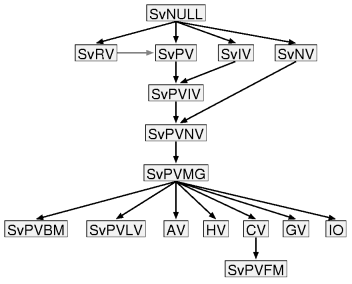
As you can see, Perl uses multiple inheritance with C SvNULL (also named just SV) acting as some kind of virtual base class. All the Perl types are identified by small numbers, and the internal Perl code often gets away with testing the ISA-relationship between types with the <= operator. As you can see from the figure above, this can only work reliably for some comparisons. All Perl data value objects are tagged with their type, so you can always ask an object what its type is and act according to this information.
The symbolic type names (and associated value) are:
- 0) SVt_NULL
- 1) SVt_IV
- 2) SVt_NV
- 3) SVt_RV
- 4) SVt_PV
- 5) SVt_PVIV
- 6) SVt_PVNV
- 7) SVt_PVMG
- 8) SVt_PVBM
- 9) SVt_PVLV
- 10) SVt_PVAV
- 11) SVt_PVHV
- 12) SVt_PVCV
- 13) SVt_PVGV
- 14) SVt_PVFM
- 15) SVt_PVIO
In addition to the simple type names already mentioned, the following names are found in the hierarchy figure: An SvPVIV value can hold a string and an integer value. AnSvPVNV value can hold a string, an integer and a double value. The SvPVMG is used when magic is attached or the value is blessed. The SvPVBM adds information for fast searching (Boyer-Moore) on the string value. The SvPVLV represents a LValue object. CV is a code value, which represents a perl function/subroutine/closure or contains a pointer to an XSUB. GV is a glob value and IO contains pointers to open files and directories and various state information about these. The SvPVFM is used to hold information on forms.
A Perl data object can change type as the value is modified. The SV is said to be upgraded in this case. Type changes only go down the hierarchy. (See the sv_upgrade() function in sv.c.)
The actual layout in memory does not really match how a typical C++ compiler would implement a hierarchy like the one depicted above. Let's see how it is done.
In the description below we use field names that match the macros that are used to access the corresponding field. For instance the
xpv_curfield of thexpvXXstructs are accessed with theSvCUR()macro. The field is referred to as CUR in the description below. This also match the field names reported by the Devel::Peek module.
SvNULL and struct sv
The simplest type is SvNULL. It always represents an undefined scalar value. It consist of the "struct sv" only, and looks like this:
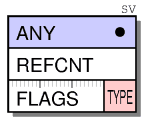
It contains a pointer (ANY) to more data, which in this case is always NULL. All the subtypes are implemented by attaching additional data to the ANY pointer.
The second field is an integer reference counter (REFCNT) which should tell us how many pointers reference this object. When Perl data types are created this value is initialized to 1. The field must be incremented when a new pointer is made to point to it and decremented when the pointer is destroyed or assigned a different value. When the reference count reaches zero the object is freed.
The third word contains a FLAGS field and a TYPE field. The TYPE field contains a small number that represents one of the types shown in the type hierarchy figure above. The FLAGS field has room for 24 flag bits, which encode how various fields of the object should be interpreted, and other state information. Some flags are just used as optimizations in order to avoid having to dereference several levels of pointers just to find that the information is not there.

The purpose of the flag bits are:
- 0) PADBUSY
- reserved for tmp or my already
- 1) PADTMP
- in use as tmp
- 2) PADMY
- in use a "my" variable
- 3) TEMP
- string is stealable
- 4) OBJECT
- This flag is set when the object is "blessed". It can only be set for value type SvPVMG or subtypes of it. This flag also indicates that the STASH pointer is valid and points to a namespace HV.
- 5) GMAGICAL (Get Magic)
- This flag indicates that the object has a magic get or len method to be invoked. It can only be set for value type SvPVMG or subtypes of it. This flag also indicate that the MAGIC pointer is valid.
- 6) SMAGICAL (Set Magic)
- This flag indicates that the object has a magic set method to be invoked.
- 7) RMAGICAL (Random Magic)
- This flag indicates that the object has any other magical methods (besides get/len/set magic method) or even methodless magic attached.
The RMAGICAL flag is used mainly for tied HV and AV (having 'P' magic) and SVs which have magic clear method. It is used as an optimization to avoid setting GMAGICAL and SMAGICAL flags for SVs which need to be marked as MAGICAL otherwise.
Any of GMAGICAL, SMAGICAL and RMAGICAL is called MAGICAL
- 8) IOK (Integer OK)
- This flag indicates that the object has a valid IVX field value. It can only be set for value type SvIV or subtypes of it.
- 9) NOK (Numeric OK)
- This flag indicates that the object has a valid NVX field value. It can only be set for value type SvNV or subtypes of it.
- 10) POK (Pointer OK)
- This flag indicates that the object has a valid PVX, CUR and LEN field values (i.e. a valid string value). It can only be set for value type SvPV or subtypes of it.
- 11) ROK (Reference OK)
- This flag indicates that the type should be treated as an SvRV and that the RV field contains a valid reference pointer.
- 12) FAKE
- glob or lexical is just a copy
- 13) OOK (Offset OK)
- This flag indicates that the IVX value is to be interpreted as a string offset. This flag can only be set for value type SvPVIV or subtypes of it. It also follows that the IOK (and IOKp) flag must be off when OOK is on. Take a look at the SvOOK figure below.
- 14) BREAK
- refcnt is artificially low
- 15) READONLY
- This flag indicate that the value of the object may not be modified.
- 16) IOKp (Integer OK Private)
- has valid non-public integer value.
The private OK flags (IOKp, NOKp, POKp) are used by the magic system. During execution of a magic callback, the private flags will be used to set the public flags. When the callback returns, then the public flags are cleared. This effectively is used to pass the value to get/set to/from magic callbacks.
- 17) NOKp (Numeric OK Private)
- has valid non-public numeric value
- 18) POKp (Pointer OK Private)
- has valid non-public pointer value
- 19) SCREAM
- has been studied
- 20) AMAGIC
- has magical overloaded methods
- 21) SHAREKEYS
- Only used by HVs. See description of HV below.
- 22) LAZYDEL
- Only used by HVs. See description of HV below.
- 22) TAIL
- Only used by SvPVBMs. See description of SvPVBM below.
- 23) VALID
- Only used by SvPVBMs. See description of SvPVBM below.
- 23) COMPILED
The struct sv is common for all subtypes of SvNULL in Perl. In the Perl source code this structure is typedefed to SV, AV, HV, CV, GV and IO. Routines that can take any type as parameter will have SV* as parameter. Routines that only work with arrays or hashes have AV* or HV* respectively in their parameter list. Likewise for the rest.
SvPV
A scalar that can hold a string value is called an SvPV. In addition to the SV struct of SvNULL, an xpv struct is allocated and it contains 3 fields. PVX is the pointer to an allocated char array. CUR is an integer giving the current length of the string. LEN is an integer giving the length of the allocated string. The byte at (PVX + CUR) should always be '\0' in order to make sure that the string is NUL-terminated if passed to C library routines. This requires that LEN is always at least 1 larger than CUR.

The POK flag indicates that the string pointed to by PVX contains an valid string value. If the POK flag is off and the ROK flag is turned on, then the PVX field is used as a pointer to an SV (see SvRV below) and CUR/LEN is unused. An SvPV with both the POK and ROK flags turned off represents undef. The PVX pointer can also be NULL when POK is off and no string storage has been allocated.
SvPVIV and SvPVNV
The SvPVIV type is like SvPV but has an additional field to hold a single integer value called IVX. The IOK flag indicates if the IVX value is valid. If both the IOK and POK flag is on, then the PVX will (usually) be a string representation of the same number found in IVX.

The SvPVNV type is like SvPVIV but has an additional field to hold a single double value called NVX. The corresponding flag is called NOK.
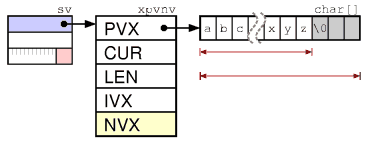
SvOOK
As a special hack, in order to improve the speed of removing characters from the beginning of a string, the OOK flag is used. When this flag is on, then the IVX value is not interpreted as an integer value, but is instead used as an offset into the string. The PVX, CUR, LEN is adjusted to point within the allocated string instead.
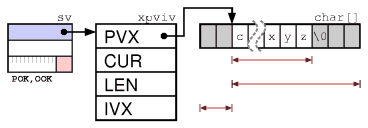
SvIV and SvNV
As a special case we also have SvIV and SvNV types that only have room for a single integer or a single double value. These are special in that the PVX/CUR/LEN fields are not present even if the ANY pointer actually points to the ghostual incarnation of them. This arrangement makes it possible for code to always access the IVX/NVX fields at a fixed offset from where the SV field ANY points.
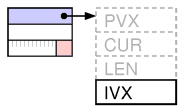
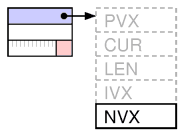
SvRV
The SvRV subtype just lets the SV field ANY point to a pointer which points to an SV (which can be any of the SvNULL subtypes). A SvRV object with ROK flag off represents an undefined value.

Subclasses of SvPV can also be treated as SvRV objects when the ROK flag is turned on for them. The PVX will then be used as the RV field of the SvRV. Of course ROK and POK is mutually exclusive and the CUR/LEN fields have no meaning when ROK is on.

SvPVMG
The SvPVMG is like SvPVNV above, but has two additional fields; MAGIC and STASH. MAGIC is a pointer to additional structures that contains callback functions and other data. If the MAGIC pointer is non-NULL, then one or more of the MAGICAL flags will be set.
STASH (symbol table hash) is a pointer to a HV that represents some namespace/class. (That the HV represents some namespace means that the NAME field of the HV must be non-NULL. See description of HVs and stashes below). The STASH field is set when the value is blessed into a package (becomes an object). The OBJECT flag will be set when STASH is. (IMHO, this field should really have been named "CLASS". The GV and CV subclasses introduce their own unrelated fields called STASH which might be confusing.)
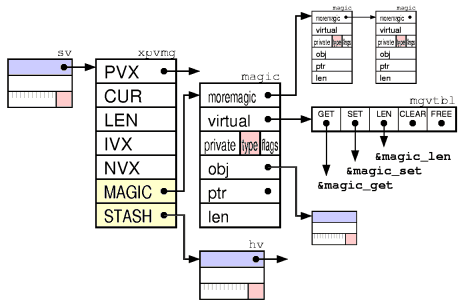
The field MAGIC points to an instance of struct magic (typedefed as MAGIC). This struct has 8 fields:
- moremagic is a pointer to another MAGIC and is used to form a single linked list of the MAGICs attached to an SV.
- virtual is a pointer to a struct containing 5 function pointers. The functions (if set) are invoked when the corresponding action happens to the SV.
- private is a 16 bit number (U16) not used by Perl.
- type is a character field and is used to denote which kind of magic this is. The interpretation of the rest of the fields depend on the type (actually it is the callbacks attached to virtual that do any interpretation). There is usually a direct correspondence between the type field and the virtual field.
- flags contains 8 flag bits. Only 2 are generally used. Bit 1 is the REFCOUNTED flag. It indicates that the obj is assumed to be an SV and that it's reference count must be decremented when this magic is freed. The GSKIP flag indicate that invocation of the magical GET method should be suppressed. Other flag bits are used depending of the kind of magic.
- obj is usually a pointer to some SV. How it is used depends on the kind of magic this is.
- ptr is usually a pointer to some character string. How it is used depends on the kind of magic this is. If the len field is >= 0, then ptr is assumed to point to a malloced buffer and will be automatically freed when the magic is.
- len is usually the length of the character string pointed to by ptr. How it is used depends on the kind of magic this is.
SvPVBM
The SvPVBM is like SvPVMG above, but has three additional fields; BmUSEFUL, BmPREVIOUS, BmRARE. The SvPVBM value types are used internally to implement very fast lookup of the string in PVX using the Boyer-Moore algorithm. They are used by the Perl index() builtin when the search string is a constant, as well as in the RE engine. The fbm_compile() function turns normal SvPVs into this value type.
A table of 256 elements is appended to the PVX. This table contains the distance from the end of string of the last occurrence of each character in the original string. (In recent Perls, the table is not built for strings shorter than 3 character.) In addition fbm_compile() locates the rarest character in the string (using builtin letter frequency tables) and stores this character in the BmRARE field. The BmPREVIOUS field is set to the location of the first occurrence of the rare character. BmUSEFUL is incremented (decremented) by the RE engine when this constant substring (does not) help in optimizing RE engine access away. If it goes below 0, then the corresponding substring is forgotten and freed;
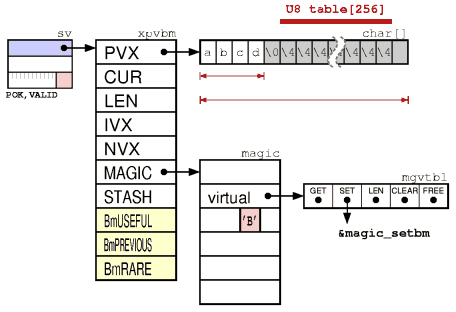
The extra SvPVBM information and the character distance table is only valid when the VALID flag is on. A magic structure with the sole purpose of turning off the VALID flag on assignment, is always attached to a valid SvPVBM.
The TAIL flag is used to indicate that the search for the SvPVMG should be tail anchored, i.e. a match should only be considered at the end of the string (or before newline at the end of the string).
SvPVLV
The SvPVLV is like SvPVMG above, but has four additional fields; TARGOFF, TARGLEN, TARG, TYPE. The typical use is for Perl builtins that can be used in the LValue context (substr, vec,...). They will return an SvPVLV value, which when assigned to use magic to affect the target object, which they keep a pointer to in the TARG field.
The TYPE is a character variable. It encodes the kind if LValue this is. Interpretation of the other LValue fields depend on the TYPE. The SvPVLVs are (almost) always magical. The magic type will match the TYPE field of the SvPVLV. The types are:
- 'x'
- Type-x LVs are returned by the
substr($string, $offset, $len)builtin.- 'v'
- Type-v LVs are returned by the
vec($string, $offset, $bits)builtin.- '.'
- Type-. LVs are returned by the
pos($scalar)builtin.- 'k'
- Type-k LVs are returned when
keys %hashis used on the left side of the assignment operator.- 'y'
- Type-y LVs are used by auto-vivification (of hash and array elements) and the foreach array iterator variable.
- '/'
- Used by pp_pushre. (I don't understand this yet.)
The figure below shows an SvPVLV as returned from the substr() builtin. The first substr parameter (the string to be affected) is assigned to the TARG field. The substr offset value goes in the TARGOFF field and the substr length parameter goes in the TARGLEN field.
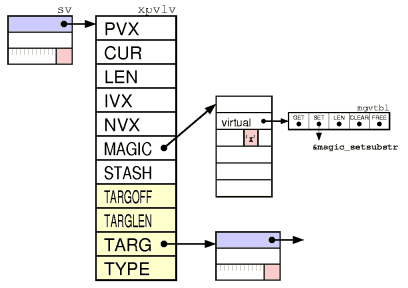
When assignment to an SvPVLV type occurs, then the value to be assigned is first copied into the SvPVLV itself (and affects the PVX, IVX or NVX). After this the magic SET method is invoked, which will update the TARG accordingly.
AV
An array is in many ways represented similar to strings. An AV contains all the fields of SvPVMG and adds the following tree fields: ALLOC is a pointer to the allocated array. ARYLEN is a pointer to a magic SV (which is returned when $#array is requested) and is only created on demand. FLAGS contains some extra flag bits that are specific of the array subtype.
The first three fields of xpvav have been renamed even though they serve nearly the same function as the corresponding SvPV fields. PVX has become ARRAY, CUR has become FILL and LEN has become MAX. One difference is that the value of FILL/MAX is always one less than CUR/LEN would be in the same situation. The IVX/NVX fields are unused.
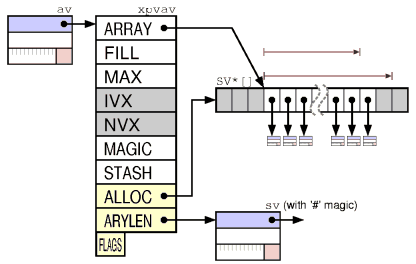
The array pointed to by ARRAY contains pointers to any of the SvNULL subtypes. Usually ALLOC and ARRAY both point to the start of the allocated array. The use of two pointers is similar to the OOK hack described above. The shift operation can be implemented efficiently by just adjusting the ARRAY pointer (and FILL/MAX). Similarly, the pop just involves decrementing the FILL count.
The are only 3 array flags defined:
- 0) REAL
- It basically means that all SVs contained in this array is owned and must have their reference counters decremented when the reference is removed from the array. All normal arrays are REAL. For the
stackthe REAL flag is turned off. For@_the REAL flag is initially turned off.- 1) REIFY
- The array is not REAL but should be made REAL if modified. The
@_array will have the REIFY flag turned on.- 2) REUSED
- This flag does not seem to be used for anything currently.
HV
Hashes are the most complex of the Perl data types. In addition to what we have seen above, HVs use HE structs to represent key/value pairs and HEK structs to represent keys.
The HV type itself contains all the fields of SvPVMG and then adds four new fields:
- RITER, EITER:
- The first two fields are used to implement a single iterator over the elements in the hash. RITER which is an integer index into the array referenced by ARRAY and EITER which is a pointer to an HE. In order find the next hash element one would first look at EITER->next and if it turns out to be NULL, RITER is incremented until ARRAY[RITER] is non-NULL. The iterator starts out with RITER = -1 and EITER = NULL.
- RMROOT/NAME:
- The last two fields are only used when the hash represents a name space (stash). PMROOT points to a node in the Perl syntax tree. It is used to implement the reset() builtin for REs. NAME is a NUL-terminated string which denotes the fully qualified name of the name space (aka package). This is one of the few places where Perl does not allow strings with embedded NULs.
The first few fields of the xpvhv have been renamed in the same way as for AVs. MAX is the number of elements in ARRAY minus one. (The size of the ARRAY is required to be a power of 2, since the code that deals with hashes just mask off the last few bits of the HASH value to locate the correct HE column for a key: ARRAY[HASH & MAX]). Also note that ARRAY can be NULL when the hash is empty (but the MAX value will still be at least 7, which is the minimum value assigned by Perl.) The FILL is the number of elements in ARRAY which are not NULL. The IVX field has been renamed KEYS and is the number of hash elements in the HASH. The NVX field is unused.
The HEs are simple structs containing 3 pointers. A pointer to the next HE, a pointer to the key and a pointer to the value of the given hash element.
The HEKs are special variable sized structures that store the hash keys. They contain 3 fields. The computed hash value of the string, the length of the string, and len+1 bytes for the key string itself (including trailing NUL). As a special case, a len value of HEf_SVKEY (-2) indicate that a pointer to an SV is stored in the HEK instead of a string. This hack is used for some magical hashes.
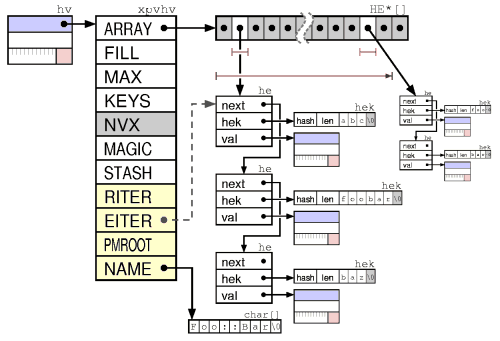
In a perfect hash both KEYS and FILL are the same value. This means than all HEs can be located directly from the pointer in the ARRAY (and all the he->next pointers are NULL).
The following two hash specific flags are found among the common SvNULL flags:
- 21) SHAREKEYS
- When this flag is set, then the hash will share the HEK structures with a special hash pointed to by the
strtabvariable. This reduce the storage occupied by hash keys, especially when we have lots of hashes with the same keys. The SHAREKEYS flag is on by default for newly created HVs.
What is special with the
strtabhash is that the val field of the HE structs is used as a reference counter for the HEK. The counter is incremented when new hashes link up this HEK and decremented when the key is removed from the hashes. When the reference count reach 0, the HEK (and corresponding HE) is removed fromstrtaband the storage is freed.- 22) LAZYDEL
- This flag indicates that the hash element pointed to by EITER is really deleted. When you delete the current hash element, perl only marks the HV with the LAZYDEL flag, and when the iterator is advanced, then the element is zapped. This makes it possible to delete elements in a hash while iterating over it.
GV
GV ("glob value" aka "symbol") is like SvPVMG above, but has five additional fields; GP, NAME, NAMELEN, GvSTASH, FLAGS.
The GP is a pointer to structure that holds pointers to data of various kinds. Perl use a pointer, instead of including the GP fields in the xpvgv, in order to implement the proper glob aliasing behavior (i.e. different GVs can share the same GP).
The NAME/NAMELEN denotes the unqualified name of this symbol and GvSTASH points to the symbol table where this symbol belongs. The fully qualified symbol name is obtained by taking the NAME of the GvSTASH (see HV above) and appending "::" and NAME to it. The hash pointed to by GvSTASH will usually contain an element with NAME as key and a pointer to this GV as value. See description of stashes below.
The FLAGS field contains space for 8 additional flag bits:
- 0) INTRO
- 1) MULTI
- Have we seen more than one occurrence of this glob. Used to implement the "possibly typo" warning.
- 2) ASSUMECV
- 4) IMPORTED_SV
- 5) IMPORTED_AV
- 6) IMPORTED_HV
- 7) IMPORTED_CV
A magic of type '*' is always attached to the GV (not shown in the figure). The magic GET method is used to stringify the globs (as the fully qualified name prefixed with '*'). The magic SET method is used to alias an GLOB based on the name of another glob.
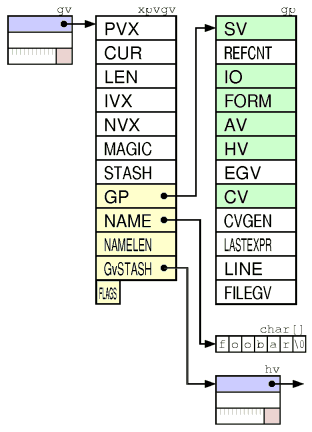
GP
GPs can be shared between one or more GVs. The data type fields for the GP are: SV, IO, FORM, AV, HV, CV. These hold a pointer to the corresponding data type object. (The SV must point to some simple SvNULL subtype (i.e. with type <= SVt_PVLV). The FORM field must point to a SvPVFM if non-NULL. The IO field must point to an IO if non-NULL, the AV to an AV, etc.) The SV is always present (but might point to a SvNULL object). All the others are initially NULL.
The additional administrative fields in the GP are: REFCNT, EGV, CVGEN, LASTEXPR, LINE, FILEGV.
REFCNT is a reference counter. It says how many GVs have a pointer to this GP. It is incremented/decremented as new GVs reference/forget this GP. When the counter reach 0 the GP is freed.
EGV is a pointer to the GV that originally created this GP (used to tell the real name of any aliased symbol). If the original GV is freed, but GP should stay since another GV reference it, then the EGV is NULLed.
CVGEN is an integer used to validate method cache CV entries in the GP. If CVGEN is zero, then the CV is real. If CVGEN is non-zero, but less than the global variablesubgeneration, then the CV contains a stale method cache entry. If CVGEN is equal to subgeneration then the CV contains a valid method cache entry. (Every time some operation that might invalidate some of the method caches are performed, then the subgeneration variable is incremented.)
LASTEXPR is an integer I don't understand the purpose of yet.
FILEGV is a pointer to a GV where the SV of the GP is the name of the file where this symbol was first created. The NAME of this GV is the filename prefixed with "_<" and GvSTASH is defstash (see description of stashes below).
LINE is the corresponding line number in the file.
Stashes
GVs and stashes work together to implement the name spaces of Perl. Stashes are named HVs with all the element values being pointers to GVs. The root of the namespace is pointed to by the global variable defstash.
In the figure below we have simplified the representation of stashes to a single box. The text in the blue field is the NAME of the HV/stash. The hash elements keys are shown as field names and the element values are shown as a pointers to globs (GV). The GVs are also simplified to a single box. The text in the green field in the fully qualified name of the GV. Only the GP data fields are shown (and FORM has been eliminated because it was not 2 letters long :-).
The figure illustrates how the scalar variables $::foo and $foo::bar::baz are represented by Perl.
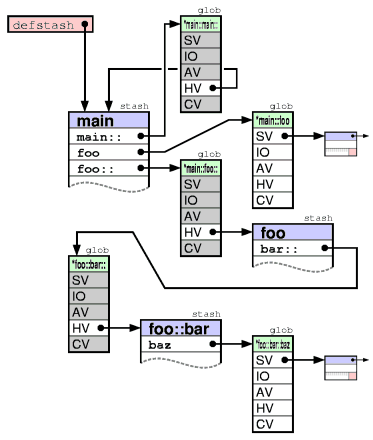
All resolution of qualified names starts with the stash pointed to by the defstash variable. Nested name spaces are implemented by a stash entry with a key ending in "::". The entry for "main::" ensures that defstash is also known as "main" package (and has the side-effect that the "main::main::main" package is defstash too.) Unqualified names are resolved starting at curstash or curcop->cop_stash which are influenced by the package declaration in Perl.
As you can see from this figure, there are lots of pointers to dereference in order to look up deeply nested names. Each stash is at least 4 levels deep and each glob is 3 levels, giving at least 24 pointer dereferences to access the data in the $foo::bar::baz variable from defstash.
The defstash stash is also a place where globs representing source files are entered. These entries are prefixed with "_<". The FILEGV field of the GP points to the same glob as the corresponding "_<" entry in defstash does.
CV
The CV ("code value") is like SvPVMG above, but has thirteen additional fields; CvSTASH, START, ROOT, XSUB, XSUBANY, GV, FILEGV, DEPTH, PADLIST, OUTSIDE, MUTEXP, OWNER, FLAGS. (The fields MUTEXP and OWNER are only present for Perls that support threading).
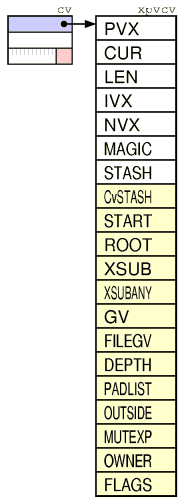
I will need to describe PADs and OPs before detailed description of CVs makes sense.
SvPVFM
The SvPVFM is like CV above, but adds a single field called LINES.
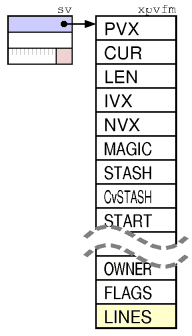
IO
The IO is like SvPVMG above, but has quite a few additional fields.
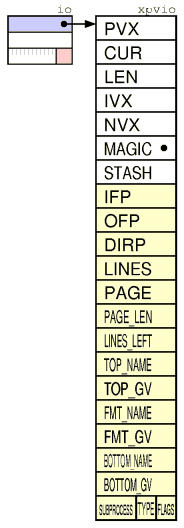
PAD
NOTYET
OP
I will perhaps make a separate document that describes syntax trees and OP codes.
Stacks
During compilation and runtime Perl use several stacks to manage itself and the program running. The first three described here implements scopes, including variables and values which are restored (or actions to be performed) when the scope is left.
The scopestack pushes the savestack_ix when ENTER is executed. On LEAVE the top savestack_ix entry is popped and all things saved on the savestack since this is restored. This means that a ENTER/LEAVE pairs represents dynamic nestable scopes.
The savestack contains records of things saved in order to be restored when the scopes are left. Each record consist of 2-4 ANY elements. The first one is a type code, which is used to decide how long the record is and how to interpret the other elements. (In the figure the type codes are marked pinkish color.) The restoring involves updating memory locations of various types as well as more general callbacks (destructors).
The tmps_stack implement mortal SVs. Each time a new mortal is made, then tmps_ix is incremented and the corresponding entry in tmps_stack made to point to it. When SAVETMPS is executed, then the old tmps_floor value is saved on the savestack and then tmps_floor is set equal to tmps_ix. When FREETMPS is executed, then all SVs pointed to by the pointers betweentmps_floor and tmps_ix will have their REFCNT decremented. How many this will be depend on how many scopes has been left. Note that the tmps_floor and tmps_ix values is the index of the last SV* pushed. They both start out as -1 when the stack is empty.
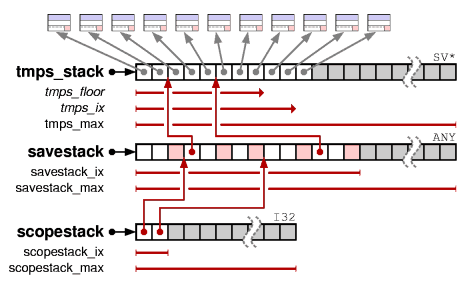
The next fours stacks manage subroutine calls, evals, and loops.
The first one is simply denoted as the stack and is really an AV. The variable curstack points to this AV. To speed up access Perl also maintain direct pointers to the start (stack_base) and the end (stack_max) of the allocated ARRAY of this AV. The AV so special that it is marked as not REAL and the FILL field is not updated. Instead we use a dedicated pointed called stack_sp, the stack pointer. The stack is used to pass arguments to PP operations and subroutines and is also the place where the result of these operations as well as subroutine return values are placed.
The markstack is used to indicate the extent of the stack to be passed as @_ to Perl subroutines. When a subroutine is to be called, then first the start of the arguments are marked by pushing thestack_sp offset onto markstack, then the arguments themselves are calculated and pushed on the stack. Then the @_ array is set up with pointers the SV* on the stack between the MARK and stack_sp and the subroutine starts running. For XSUB routines, the creation of @_ is suppressed, and the routine will use the MARK directly to find it's arguments.
The retstack contains pointers to the operation to go to after subroutines return. Each time a subroutine is called a new OP* is pushed on this stack. When a subroutine returns, Perl pop the top OP* from retstack and continue execution from this place.
The cxstack (context stack) contains records that describe the current context. Each time a subroutine, an eval or a loop is entered, then a new PERL_CONTEXT record is pushed on the cxstack. When subroutine/eval/loop finished then the record top record is poped and the corresponding values restored. The PERL_CONTEXT record will eventually be descibed below.

PERL_CONTEXT
NOTYET
REGEXP
NOTYET
PerlInterpreter
NOTYET
Perl 内部结构详解的更多相关文章
- perl 变量详解
http://www.perlmonks.org/?node_id=933450 use strict; use Devel::Peek; my $a; Dump($a); $a=4; Dump($a ...
- perl 正则详解
用/s 来匹配任意字符 默认情况下,点号(.)无法匹配换行符,这对大多数单行匹配的情况是合适的. . 圆点用于匹配除换行符外的任何单个字符 + 意味着一个或多个相同的字符 .+ 匹配任意单个字符至少一 ...
- Spark内部结构详解
参考: https://github.com/JerryLead/SparkInternals/blob/master/markdown/english/5-Architecture.md?winzo ...
- [转帖]rename(Perl语言版本) 详解
rename(Perl语言版本) 详解 2019-03-19 22:51:23 wayne17 阅读数 464更多 分类专栏: Ubuntu之路 版权声明:本文为博主原创文章,遵循CC 4.0 B ...
- 服务器.htaccess 详解以及 .htaccess 参数说明(转载)
htaccess文件(或者”分布式配置文件”)提供了针对目录改变配置的方法, 即,在一个特定的文档目录中放置一个包含一个或多个指令的文件, 以作用于此目录及其所有子目录.作为用户,所能使用的命令受到限 ...
- .htaccess详解及.htaccess参数说明【转】
目录(?)[-] htaccess 详解 htaccess rewrite 规则详细说明 RewriteEngine OnOff RewriteBase URL-path RewriteCond Te ...
- lucene、lucene.NET详细使用与优化详解
lucene.lucene.NET详细使用与优化详解 2010-02-01 13:51:11 分类: Linux 1 lucene简介1.1 什么是luceneLucene是一个全文搜索框架,而不是应 ...
- 【转】.htaccess详解及.htaccess参数说明
.htaccess文件(或者”分布式配置文件”)提供了针对目录改变配置的方法, 即,在一个特定的文档目录中放置一个包含一个或多个指令的文件, 以作用于此目录及其所有子目录.作为用户,所能使用的命令受到 ...
- .htaccess详解及.htaccess参数说明
.htaccess文件(或者”分布式配置文件”)提供了针对目录改变配置的方法, 即,在一个特定的文档目录中放置一个包含一个或多个指令的文件, 以作用于此目录及其所有子目录.作为用户,所能使用的命令受到 ...
随机推荐
- MapReduce阅读
1.mongodb权威指南6.4章 2.百科:http://baike.baidu.com/link?url=fl9FwgNq7gtFLwJ-GuKsJ25Uk-wnhgDjEwkKd8-5hoIkh ...
- 《学习OpenCV》练习题第四章第二题
#include <highgui.h> #include <cv.h> #pragma comment (lib,"opencv_calib3d231d.lib&q ...
- 20151007kaggle Titanic心得
Titanic是kaggle上一个练手的比赛,kaggle平台提供一部分人的特征,以及是否遇难,目的是预测另一部分人是否遇难.目前抽工作之余,断断续续弄了点,成绩为0.79426.在这个比赛过程中,接 ...
- SQL Server UDF用户自定义函数
UDF的定义 和存储过程很相似,用户自定义函数也是一组有序的T-SQL语句,UDF被预先优化和编译并且尅作为一个单元爱进行调用.UDF和存储过程的主要区别在于返回结果的方式. 使用UDF时可传入参数, ...
- [置顶] 如何在浏览器中打开PDF文件并实现预览的思路与代码
编写项目遇到一个需要在浏览器中打开PDF文件的问题.最终实现效果如下: 其实也就是简单的在浏览器中实现一个打开pdf文件,并有类似预览功能的边框. 其实在网上经常见到类似的页面,在浏览器中打开pdf文 ...
- FZU 8月有奖月赛A Daxia & Wzc's problem (Lucas)
Problem A Daxia & Wzc's problem Accept: 42 Submit: 228Time Limit: 1000 mSec Memory Limit : ...
- C#上位机读数据库
string connectionString = string.Format("server=(local);uid=sa;pwd=1234567890;database=msp430&q ...
- hdoj 1729 Stone Games(SG函数)
题目链接:http://acm.hdu.edu.cn/showproblem.php?pid=1729 看了题目感觉像Nim,但是有范围限制,有点不知道SG函数该怎么写 看了题解,最后才明白该怎么去理 ...
- cmd命令。
CMD按任意退出 echo 退出……按任意键pause & exit
- erlang web socket参考。
出自: http://blog.sina.com.cn/s/blog_96b8a15401010g71.html


























